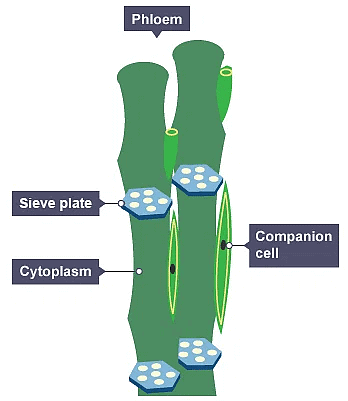Grade 10 Exam > Grade 10 Notes > Biology for Grade 10 > Plant Organ System
Plant Organ System | Biology for Grade 10 PDF Download
| Table of contents |

|
| Plant transport tissues - Xylem and Phloem |

|
| Comparison of transport in the xylem and phloem |

|
| The Need for Transport in Plants |

|
| Solved Example |

|
Plant transport tissues - Xylem and Phloem
Xylem
- The xylem transports water and minerals from the roots up the plant stem and into the leaves.
- In a mature flowering plant or tree, most of the cells that make up the xylem are specialised cells called vessels.
Vessels
- Lose their end walls so the xylem forms a continuous, hollow tube.
- Become strengthened by a chemical called lignin. The cells are no longer alive. Lignin gives strength and support to the plant. We call lignified cells wood.
- Transport in the xylem is a physical process. It does not require energy.

Phloem
The phloem moves food substances that the plant has produced by photosynthesis to where they are needed for processes such as:
- growing parts of the plant for immediate use
- storage organs such as bulbs and tubers
- developing seeds.
Transport in the phloem is therefore both up and down the stem. Transport of substances in the phloem is called translocation.
Phloem consists of living cells. The cells that make up the phloem are adapted to their function:
- Sieve tubes - specialised for transport and have no nuclei. Each sieve tube has a perforated end so its cytoplasm connects one cell to the next.
- Companion cells - transport of substances in the phloem requires energy. One or more companion cells attached to each sieve tube provide this energy. A sieve tube is completely dependent on its companion cell(s).

Comparison of transport in the xylem and phloem

The Need for Transport in Plants
- Plants need to take up water, minerals and carbon dioxide, and transport them to the leaves for photosynthesis. They then move the products of photosynthesis to where they're needed in the plant.
- For simple multicellular organisms, such as small plants such as mosses, substances diffuse into the leaves and simple roots over their surface.
- Once inside the plant, they don't need to move far. They can move into and around the plants by diffusion and osmosis.
- Larger organisms do not have sufficient absorbing area to meet their needs. Their needs are represented by their volume.
- Look at these surface areas and volumes:

- As their size increases, their surface area in relation to their volume decreases.
- As the ratio is 0.6 to one, the one can be omitted and simply expressed as 0.6. There aren't any perfect cube-shaped organisms, but the same principles apply to small and large ones.
- Once inside a larger organism, a substance will also have further to travel to diffuse.
- Larger plants and animals need transport systems and to ensure that they have sufficient absorbing surface area. This could be additional surfaces, such as the digestive system and lungs in animals, or adaptations such as the flattened shape of leaves, which increase their surface area.
- Larger, more complex plants have two types of transport systems - xylem and phloem.
Solved Example
Example: What is the surface area:volume ratio of a cube 10 cm × 10 cm × 10 cm?
0.6:1 or 0.6
The surface area = 10 cm × 10 cm × 6 = 600 cm2 (multiple by six here because a cube has six faces.)
The volume = 10 cm × 10 cm × 10 cm = 1000 cm3
The surface area: volume ratio = 600:1000 = 0.6:1
The document Plant Organ System | Biology for Grade 10 is a part of the Grade 10 Course Biology for Grade 10.
All you need of Grade 10 at this link: Grade 10
|
110 videos|93 docs|9 tests
|

|
Explore Courses for Grade 10 exam
|

|
Signup for Free!
Signup to see your scores go up within 7 days! Learn & Practice with 1000+ FREE Notes, Videos & Tests.
Related Searches



















